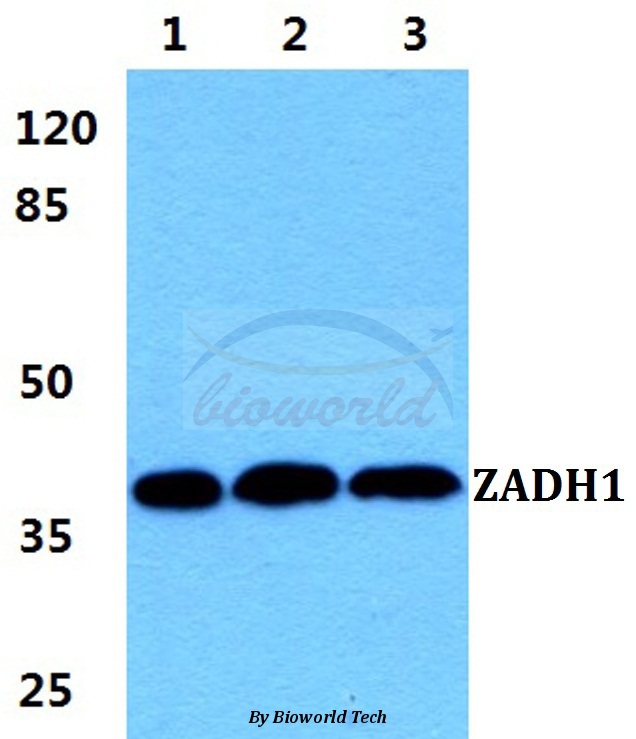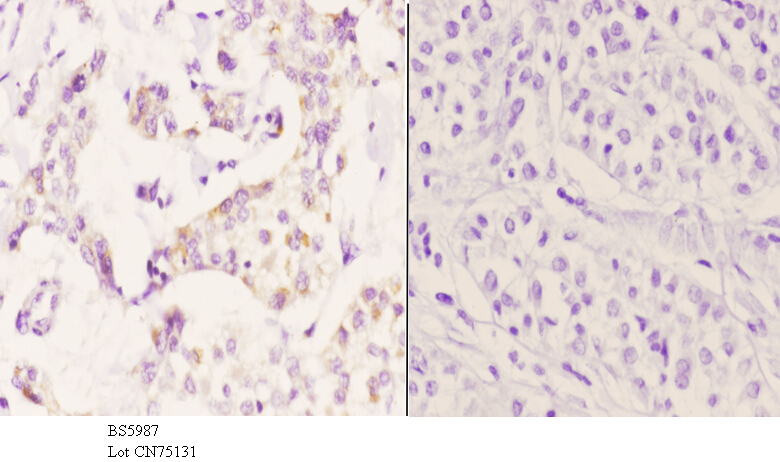Product Name :
ZADH1 polyclonal antibody Background :
ZADH1 (zinc binding alcohol dehydrogenase,domain containing 1), also known as PTGR2 (prostaglandin reductase 2), PGR2 or 15-oxoprostaglandin 13-reductase, is a 351 amino acid cytoplasmic protein that belongs to the NADP-dependent oxidoreductase L4BD family. Functioning as s a 15-oxoprostaglandin 13-reductase, ZADH1 catalyzes the conversion of 15-keto-prostaglandin E2 to 15-keto-13,14-dihydro-prostaglandin E2 in a NADPH-dependent manner. ZADH1 overexpression has been found to repress PPARγ transcriptional activity and adipocyte differentiation. Widely expressed, ZADH1 is found at highest levels in heart, kidney, liver, pancreas and prostate, with moderate levels found in brain, small intestine, lung, testis and skeletal muscle. ZADH1 exists as a monomer, utilizes NADPH as a cofactor, and undergoes alternative splicing to produce two isoforms that are encoded by a gene located on human chromosome 14q24.3. Product :
Rabbit IgG, 1mg/ml in PBS with 0.02% sodium azide, 50% glycerol, pH7.2 Storage&Stability :
Store at 4°C short term. Aliquot and store at -20°C long term. Avoid freeze-thaw cycles. Specificity :
ZADH1 polyclonal antibody detects endogenous levels of ZADH1 protein. Immunogen :
Synthetic peptide, corresponding to amino acids 228-273 of Human ZADH1. Conjugate :
Unconjugated Modification :
Unmodification
ZADH1 polyclonal antibody Background :
ZADH1 (zinc binding alcohol dehydrogenase,domain containing 1), also known as PTGR2 (prostaglandin reductase 2), PGR2 or 15-oxoprostaglandin 13-reductase, is a 351 amino acid cytoplasmic protein that belongs to the NADP-dependent oxidoreductase L4BD family. Functioning as s a 15-oxoprostaglandin 13-reductase, ZADH1 catalyzes the conversion of 15-keto-prostaglandin E2 to 15-keto-13,14-dihydro-prostaglandin E2 in a NADPH-dependent manner. ZADH1 overexpression has been found to repress PPARγ transcriptional activity and adipocyte differentiation. Widely expressed, ZADH1 is found at highest levels in heart, kidney, liver, pancreas and prostate, with moderate levels found in brain, small intestine, lung, testis and skeletal muscle. ZADH1 exists as a monomer, utilizes NADPH as a cofactor, and undergoes alternative splicing to produce two isoforms that are encoded by a gene located on human chromosome 14q24.3. Product :
Rabbit IgG, 1mg/ml in PBS with 0.02% sodium azide, 50% glycerol, pH7.2 Storage&Stability :
Store at 4°C short term. Aliquot and store at -20°C long term. Avoid freeze-thaw cycles. Specificity :
ZADH1 polyclonal antibody detects endogenous levels of ZADH1 protein. Immunogen :
Synthetic peptide, corresponding to amino acids 228-273 of Human ZADH1. Conjugate :
Unconjugated Modification :
Unmodification
-
 Western blot (WB) analysis of ZADH1 polyclonal antibody at 1:500 dilution Lane1:Hela cell lysate Lane2:sp2/0 cell lysate Lane3:PC12 cell lysate
Western blot (WB) analysis of ZADH1 polyclonal antibody at 1:500 dilution Lane1:Hela cell lysate Lane2:sp2/0 cell lysate Lane3:PC12 cell lysate -
 Immunohistochemistry (IHC) analyzes of ZADH1 pAb in paraffin-embedded human liver carcinoma tissue at 1:50.showing cytoplasmic staining. Negative control (the right)Using PBS instead of primary antibody, secondary antibody is Goat Anti-Rabbit IgG-biotin followed by avidin-peroxidase.
Immunohistochemistry (IHC) analyzes of ZADH1 pAb in paraffin-embedded human liver carcinoma tissue at 1:50.showing cytoplasmic staining. Negative control (the right)Using PBS instead of primary antibody, secondary antibody is Goat Anti-Rabbit IgG-biotin followed by avidin-peroxidase.
Bioworld Biotech only provide peptides for our antibodies and do not provide additional peptide customization services.
Price/Size :
USD 368/1mg/vial
Tips:
For phospho antibody, we provide phospho peptide(0.5mg) and non-phospho peptide(0.5mg).Describe :
Blocking peptides are peptides that bind specifically to the target antibody and block antibody binding. These peptide usually contains the epitope recognized by the antibody. Antibodies bound to the blocking peptide no longer bind to the epitope on the target protein. This mechanism is useful when non-specific binding is an issue, for example, in Western blotting (WB) and Immunohistochemistry (IHC). By comparing the staining from the blocked antibody versus the antibody alone, one can see which staining is specific; Specific binding will be absent from the western blot or IHC performed with the neutralized antibody.Formula:
Synthetic peptide was lyophilized with 100% acetonitrile and is supplied as a powder. Reconstitute with 0.1 ml DI water for a final concentration of 10 mg/ml.The purity is >90%,tested by HPLC and MS.
Storage:
The freeze-dried powder is more stable. For short time at 2-8°C. For long term storage store at -20°C.
Note :
This product is for research use only (RUO only). Not for use in diagnostic or therapeutic procedures.
 ZADH1 polyclonal antibody
ZADH1 polyclonal antibody  Datasheet
Datasheet COA
COA MSDS
MSDS SHIP
SHIP